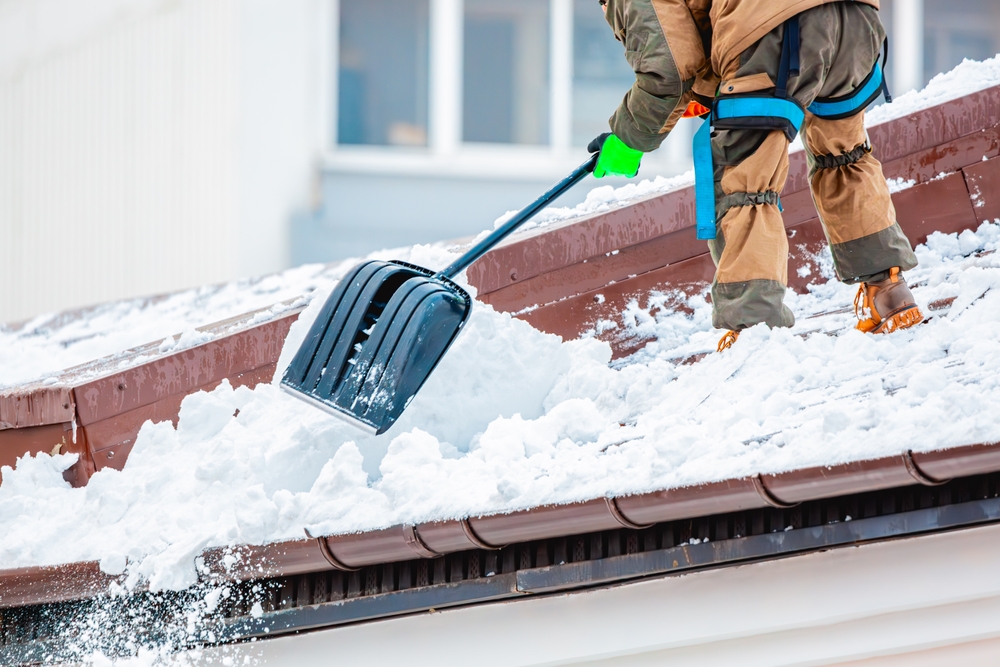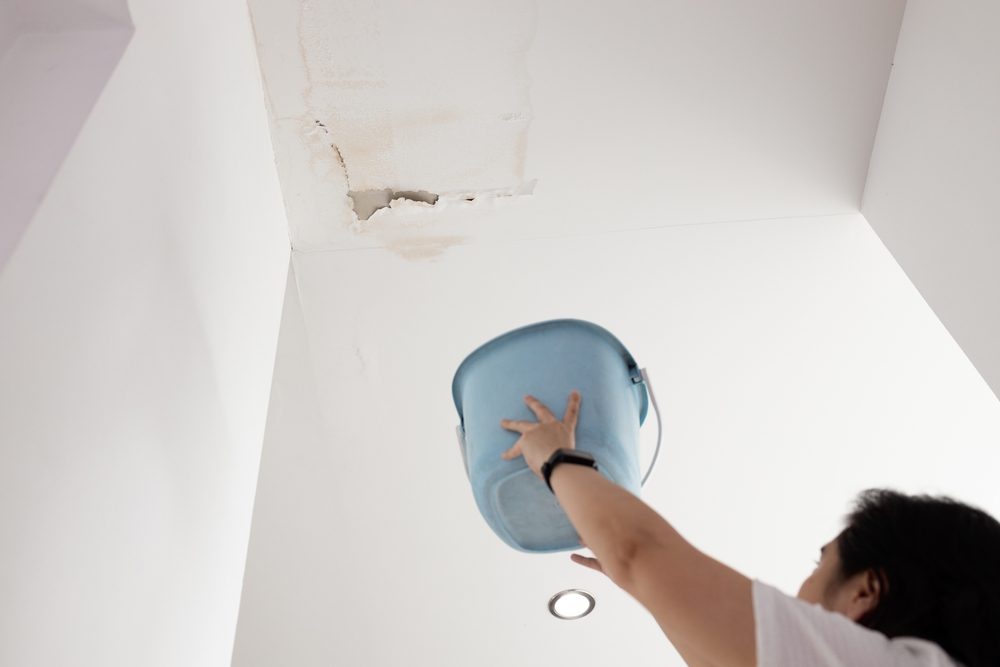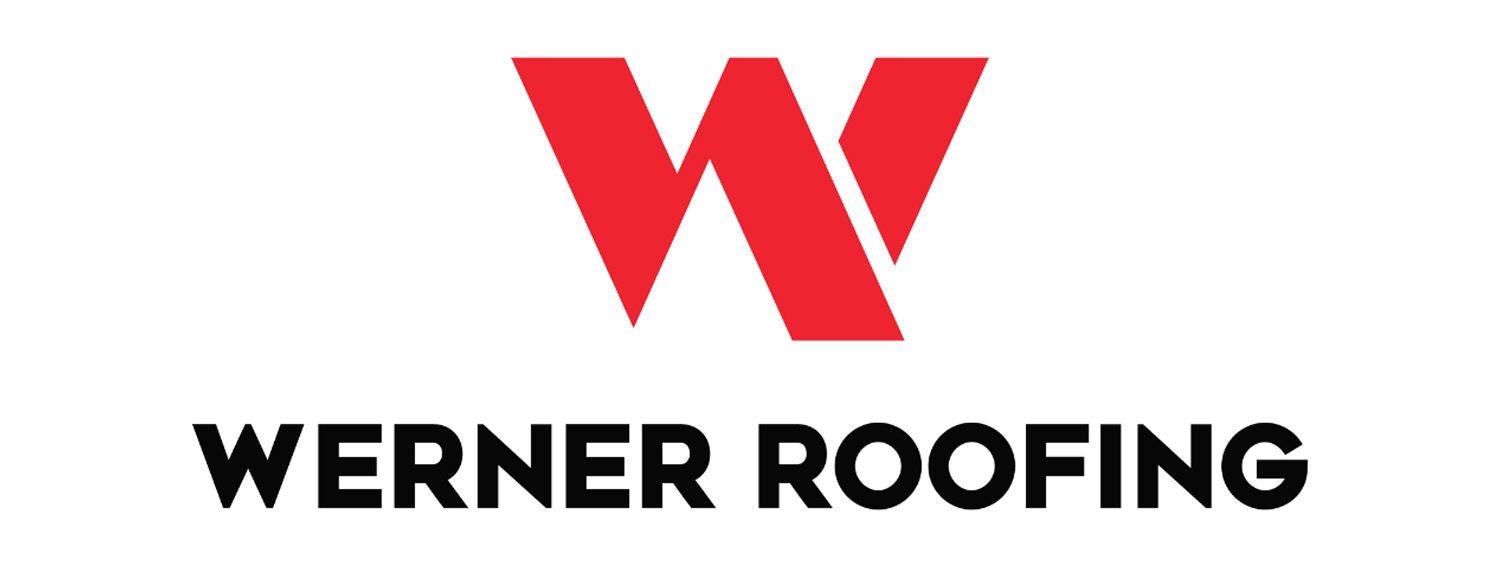
by elizabeth@evenbound.com | Oct 29, 2025 | Roof Damage, Roof Maintenance
If you live in Grand Rapids, you know winter doesn’t mess around. Heavy lake effect snow, freezing temperatures, and high winds can put even the best roofs to the test.
As a roofing professional, I’ve seen how quickly a beautiful blanket of snow can cause ice dams, leaks, or worse—structural roof damage.
That’s why taking a few preventative steps before the snow starts flying is so important. Below, I’ll explain what makes lake effect snow so tough on your roof, what risks to watch for, and what you can do to keep your home protected all winter long.
Understanding the Lake Effect Snow in Grand Rapids
Lake effect snow happens when cold air passes over Lake Michigan’s warmer waters. The lake adds moisture to the air, dumping heavy, wet snow once it hits land. This is especially common here in West Michigan.
Did you know? Unlike light, powdery snow, lake effect snow is dense and water-heavy. That extra weight adds stress to your roof and can speed up ice dam formation, especially if your attic isn’t properly insulated or ventilated.
The result? Melted snow can refreeze at the roof’s edge, blocking proper drainage and forcing water under your shingles.
The Risks Snow and Ice Pose to Roofs
Snow may look harmless, but it brings several hidden dangers:
- Ice dams and leaks: Melted snow that refreezes can back up under shingles, causing water intrusion.
- Shingle damage: The freeze-thaw cycle can crack or loosen shingles.
- Excess weight: Too much snow buildup can lead to sagging or even structural strain.
- Mold and mildew: Moisture trapped under shingles or in attics can cause long-term indoor issues.
These problems often start small—but if ignored, they can become expensive repairs by midwinter.
3 Roof and Snow Safety Tips for the Michigan Lake Effect
1. Preventive Roof Maintenance Before Winter
A little fall roof maintenance goes a long way in preventing winter headaches:
- Clean your gutters so melting snow and ice have a clear path to drain. Clogged gutters trap water that can freeze and push under shingles.
- Check your shingles and flashing. Damaged or missing pieces create easy entry points for water.
- Inspect attic insulation and ventilation. Proper airflow keeps your roof’s surface cold, reducing the chance of ice dams.
If you’re uncomfortable doing these checks yourself, schedule a free professional inspection with Werner Roofing. We’ll make sure your roof, flashing, and gutters are winter-ready.
2. Safe Snow Removal Practices
It’s tempting to climb up there and clear your roof after a heavy snowfall—but please, don’t. Walking on icy shingles is one of the most dangerous winter tasks a homeowner can attempt.
Instead:
- Use a roof rake with a long extension handle to pull down excess snow safely from the ground.
- Focus on clearing the first few feet above the gutters to help prevent ice dams.
- As a rule of thumb, if snow buildup exceeds 6 inches of dense, wet snow, it’s worth removing.
- If the accumulation is heavy or hard to reach, call a professional. It’s safer and often more affordable than repairing roof damage later.
3. Spotting Warning Signs of Trouble
Keep an eye out for these early indicators that your roof may be struggling:
- Large icicles along the eaves
- Water stains on ceilings or upper walls
- Sagging rooflines or dips in the structure
- Persistent ice dams in the same areas after each snowfall
Catching these warning signs early can save you thousands in repairs.
Why Professional Help Matters
Even if you’re diligent about roof maintenance, Michigan winters can still throw surprises your way. Professional roofers have the right tools, safety equipment, and experience to handle those challenges safely and effectively.
At Werner Roofing, we’ve helped thousands of West Michigan homeowners prepare for (and recover from) harsh lake effect conditions. Our team knows what to look for, from minor flashing gaps to hidden moisture damage, and we’ll help you address issues before they escalate.
Preventive care is always more affordable than emergency repair. A quick inspection now can mean a dry, stress-free winter later.
Don’t Wait Until It’s Too Late, We’re Here To Help
Once the snow hits, it’s too late to fix what’s underneath. If you haven’t had your roof inspected this year, now’s the time!
Schedule your free roof inspection today with Werner Roofing and head into winter knowing your home is protected from whatever lake effect snow brings.

by elizabeth@evenbound.com | Sep 19, 2025 | Roof Damage, Roof Repair
Your roof does more than just keep the rain out—it’s a complex system designed to direct water safely away from vulnerable areas. One of the most important components of a roof system is roof flashing. These thin strips of metal are installed around chimneys, skylights, vents, and roof valleys to seal joints and keep water from seeping inside.
If flashing is damaged, poorly installed, or worn down over time, it can quickly lead to roof leaks, water damage, and even structural issues. If left unchecked, a small gap can become a costly problem for your home.
In this blog, we’ll explain what roof flashing is and why it matters, walk through five common causes of flashing damage, share the key signs it’s time for a repair, and show why trusting a professional is the best way to protect your investment.
What Is Roof Flashing and Why Does It Matter?
Roof flashing is one of those roofing components you rarely notice but can’t live without. It’s made of thin metal pieces (usually aluminum, copper, or galvanized steel) installed in critical areas where your roof meets other structures, like chimneys, skylights, vents, and valleys.
Flashing directs water away from vulnerable joints and openings. Without it, rainwater and melting snow could easily sneak under your shingles, seep into your roof deck, and cause leaks, mold, and structural deterioration.
Think of flashing as your roof’s line of defense against water damage. When it’s properly installed and maintained, flashing protects your home’s integrity. But your entire roof system can be at risk when missing, damaged, or corroded.

5 Common Causes of Roof Flashing Damage
Even the best roofing materials don’t last forever, and flashing is no exception. Here are some of the most common reasons flashing can fail:
1. Weather Exposure
High winds, heavy rain, snow, and hail can loosen, dent, or tear flashing. Over time, repeated exposure to Michigan’s unpredictable weather weakens its protective seal.
2. Poor Installation
Water can sneak through gaps if flashing is not aligned correctly or sealed. This is one of the leading causes of premature roof leaks, especially around chimneys and skylights.
3. Corrosion or Material Wear
Metal flashing can rust, corrode, or deteriorate with age. Once weakened, it loses its ability to keep water out.
4. Roof Movement
Your roof naturally expands and contracts with temperature changes. This shifting can cause flashing to pull away from its seal, leaving vulnerable gaps behind.
5. Storm Damage
Severe storms can knock debris into your roof, while ice dams in the winter can lift or bend flashing out of place. Both create opportunities for water intrusion.
Signs You May Need Roof Flashing Repair
Because flashing is tucked away at roof joints and edges, it’s not always easy to spot when it’s failing. Still, there are some clear warning signs homeowners can watch for:
- Water stains on ceilings or walls — often the first visible clue that water is sneaking past your roof’s defenses.
- Dampness or leaks near chimneys, vents, or skylights — prime spots where flashing plays a critical role.
- Loose, bent, or visibly damaged flashing — if you can see it from the ground or during a roof inspection, it’s time to act.
- Mold or mildew growth in the attic — moisture buildup often traces back to flashing issues.
- Persistent roof leaks after storms — if problems continue even after patching shingles, flashing may be the culprit.
Catching these issues early can mean the difference between a simple flashing repair and a major roof replacement.
How Does Roof Flashing Repair Work?
When flashing fails, it’s vital to repair it correctly to restore your roof’s watertight seal. Here’s what the typical repair process looks like:
- Inspection – A roofing professional will carefully inspect your roof to pinpoint problem areas and assess the extent of the damage.
- Removal of Damaged Flashing – Old or deteriorated flashing is removed to make way for a secure replacement.
- Surface Preparation – The area is cleaned and prepped to ensure the new flashing bonds properly and creates a lasting seal.
- Installation of New Flashing – Fresh flashing is fitted and sealed into place with high-quality materials designed to withstand the elements.
While it may be tempting to attempt a DIY fix, flashing repair is best left to the professionals. Improper installation can make leaks worse, compromise your roof warranty, and put your safety at risk.
Why Professional Roof Flashing Repair Is Worth It
Cutting corners on flashing repair isn’t worth the risk when protecting your home. Here’s why hiring a professional roofing contractor pays off:
- Expertise in spotting hidden damage – Professionals know where to look and can uncover problems you might miss.
- Proper installation with quality materials – Roofers use flashing to withstand Michigan’s harsh weather, ensuring long-term protection.
- Repairs that prevent future leaks – Correctly installed flashing not only fixes current issues but also safeguards against future water intrusion.
- Cost savings in the long run – Investing in professional repairs now can save you thousands by preventing structural damage, mold, and premature roof replacement.
A reliable roofing expert doesn’t just repair the flashing — they protect the entire system that keeps your home safe and dry.

Protect Your Home With Expert Roof Flashing Repair from Werner Roofing
At Werner Roofing, our team has the experience and expertise to diagnose flashing issues, repair them properly, and give you peace of mind that your home is protected against the elements.
If you’ve noticed any signs of roof flashing damage, contact Werner Roofing today for a free inspection and expert repair you can trust.

by elizabeth@evenbound.com | Aug 19, 2024 | Roof Damage
Storms can be unpredictable, and, unfortunately, they often leave homeowners dealing with the aftermath of roof damage. Whether it’s missing shingles, sprung a leak, or has severe structural issues, damage to your roof can be devastating. However, taking quick, well-informed steps can make all the difference in protecting your home and ensuring a smooth roof damage insurance claims process.
10 Steps to Take After Your Roof Is Damaged In a Storm
At Werner Roofing, we understand the stress of storm damage and are here to help you every step of the way. We’ll walk you through the essential steps to take if your roof is damaged in a storm so you can confidently navigate the insurance claims process.
1. Ensure Safety First!
Your personal safety should always be the top priority. Remember, no amount of roof damage is worth risking your or your family’s safety.
- Before you inspect the damage, make sure there are no immediate dangers, such as fallen power lines, loose tree branches, or structural instability in your home.
- Stay indoors until you’re certain it’s safe to go outside.
2. Document the Damage
Proper documentation will be vital when filing your roof damage insurance claim.
- Once it’s safe, start documenting the damage as thoroughly as possible. Use your phone or camera to take clear, detailed photos and videos of damage to your roof and property.
- Make sure to capture different angles and include close-ups.
- Don’t forget to note the date and time the storm occurred and the extent of the damage.
3. Understand Your Insurance Policy
Next, it’s time to dive into your homeowner’s insurance policy.
- Familiarize yourself with what is covered and what isn’t. Pay special attention to any specific requirements or limitations related to storm damage.
- Understanding your coverage will help you manage expectations and prepare for the claims process.
4. Report the Damage to Your Insurance Company
The sooner you report the damage to your insurance company, the better.
- Contact your insurance company as soon as possible, providing all the documentation you’ve gathered.
- The faster you start the claims process, the sooner you can get your roof repaired and your home back to normal.
5. Schedule an Inspection with an Insurance Adjuster
After reporting the damage, arrange for an insurance adjuster to come and inspect your roof.
- It’s best to be present during this inspection to answer any questions and ensure the adjuster sees all the documented damage. Your involvement can help avoid any misunderstandings or missed details.
6. Communicate Effectively
Clear communication with your insurance company is key.
- Clearly explain the extent of the damage and any immediate repairs you had to make to prevent further issues.
- Keep the communication lines open, and follow up regularly to ensure the claims process keeps moving forward.
7. Gather Necessary Documentation
Your photos and documentation from earlier will come in handy here, too – providing comprehensive documentation can streamline the process and help ensure your claim is processed smoothly.
- Prepare a detailed list of damages and associated costs to support your claim. This list should include estimates for repairs or replacement from reputable roofing contractors like Werner Roofing.
8. Submit Your Roof Damage Insurance Claim
This step is critical in moving the process forward and getting your roof repaired.
- Complete all the necessary forms and submit your roof damage insurance claim and the required documentation.
- Be sure to keep copies of everything for your records.
9. Choose a Reputable Contractor to Repair Your Roof
Selecting a trustworthy, experienced roofing contractor is crucial to ensuring your roof is repaired correctly.
- Start by researching local roofing contractors and verifying their credentials.
- Look for companies that are licensed, insured, and have a solid reputation in your community.
- Reading reviews, checking ratings with the Better Business Bureau, and asking for references from neighbors can give you insight into the contractor’s reliability and quality of work.
- Werner Roofing’s expertise and commitment to customer satisfaction make us a reliable choice. We understand the importance of quality repairs and stand by our work.
10. Schedule Roof Repairs
Finally, coordinate with your contractor and insurance company to schedule repairs to get your roof back in tip-top shape.
- Make sure all work meets insurance requirements and is completed to your satisfaction.
- With Werner Roofing, you can be confident that your roof will be restored to its best condition, protecting your home for years to come.
Preventative Measures to Keep Your Roof Safe in the Future
Taking proactive steps to safeguard your roof can make all the difference when severe weather strikes. By focusing on regular maintenance and storm preparation, you can ensure your roof is in the best possible condition to withstand whatever the elements may bring.
Regular Maintenance
The best way to protect your roof from future damage is through regular maintenance.
- Routine roof inspections and upkeep can catch small issues before they turn into major problems, saving you time, money, and stress in the long run.
- Clearing debris regularly, checking for loose or damaged shingles, and ensuring your gutters are properly functioning are all critical.
Werner Roofing offers comprehensive maintenance services to keep your roof in shape year-round. Our team will conduct thorough inspections, address any minor repairs, and provide expert advice on how to maintain your roof, helping you prevent future damage and extend the lifespan of your roofing system.
Storm Preparation
Preparing your roof before a storm hits is another crucial step in safeguarding your home.
- Start by securing any loose shingles, clearing your gutters, and trimming overhanging tree branches that could pose a threat during high winds.
- Inspect your roof for any weaknesses, such as small leaks or cracks that could worsen during a storm.
Werner Roofing is here to help with all your storm preparation needs. Our experts can assess your roof’s condition, perform any necessary pre-storm repairs, and offer guidance on additional measures you can take to protect your home.
Trust Werner To Protect Your Home’s Roof
Navigating storm damage and insurance claims can be stressful, but with the proper guidance and a reliable partner, you can restore your roof and peace of mind. Werner Roofing will support you every step of the way, from storm preparation to repairs and everything in between.
Don’t wait—contact Werner Roofing today to keep your roof and home safe and secure, no matter what the weather brings.






